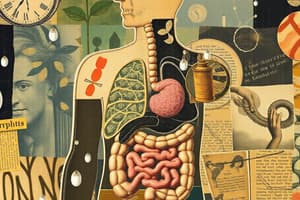Podcast
Questions and Answers
What are autotrophs?
What are autotrophs?
Organisms that can produce their own food using light, water, carbon dioxide, and energy through photosynthesis.
According to the Arrhenius theory, what defines acids?
According to the Arrhenius theory, what defines acids?
Substances that release hydrogen ions (H⁺) when dissolved in water.
What is the main difference between chemical changes and physical changes?
What is the main difference between chemical changes and physical changes?
Chemical changes involve the breaking or forming of chemical bonds, leading to new substances, while physical changes only alter appearance without changing the chemical composition.
List three examples of autotrophs.
List three examples of autotrophs.
Give two examples of common acids.
Give two examples of common acids.
Study Notes
Autotrophs, Acids, and Changes: An Exploratory Guide
From photosynthesis to chemical reactions, the natural world is teeming with fascinating processes. Let's dive into autotrophs, acids, and the transformations they're involved in, bringing our understanding of these concepts to life.
Autotrophs
Autotrophs are organisms that can produce their own food using light, water, carbon dioxide, and energy, through a process called photosynthesis. These organisms form the base of all food webs.
Notable autotrophs include:
- Plants
- Algae
- Some bacteria
Autotrophs create energy-rich organic molecules, like glucose, that other organisms can use for energy.
Acids
Acids, according to the Arrhenius theory, are substances that release hydrogen ions (H⁺) when dissolved in water. They form hydronium ions (H₃O⁺), which can be detected by their sour taste and ability to turn litmus paper red.
Examples of acids include:
- Hydrochloric acid (HCl)
- Citric acid (C₆H₈O₇)
- Carbonic acid (H₂CO₃)
Chemical Changes
Chemical changes, also known as chemical reactions, involve the breaking or forming of chemical bonds between atoms. Chemical changes can lead to new substances, different properties, and energy release or absorption.
Physical Changes
Physical changes, on the other hand, are changes in a substance's appearance without a change in its chemical composition. They do not involve the formation or breaking of chemical bonds.
Examples of physical changes include:
- Melting
- Boiling
- Dissolving
Heterotrophs
Heterotrophs are organisms that rely on other organic matter for their energy and nutrients. They are decomposers or consumers.
Examples of heterotrophs include:
- Animals
- Fungi
- Some bacteria
Heterotrophs draw energy from autotrophs through their consumption, and they help recycle nutrients into forms that can be used by autotrophs.
Understanding these concepts can help us appreciate the complex and interdependent natural world around us. Whether we're following the path of a glucose molecule through photosynthesis, setting up a reaction in chemistry class, or watching fungi break down decaying leaves, we're uncovering the fascinating workings of our environment.
Studying That Suits You
Use AI to generate personalized quizzes and flashcards to suit your learning preferences.
Description
Test your knowledge on autotrophs that produce their own food through photosynthesis, acids that release hydrogen ions in water, and chemical changes involving the breaking or forming of chemical bonds. Explore the interconnected processes in the natural world.




